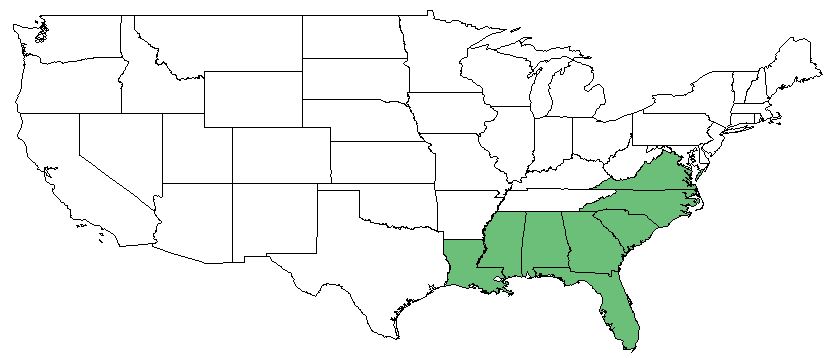Difference between revisions of "Dichanthelium chamaelonche"
(→Ecology) |
|||
| Line 29: | Line 29: | ||
==Ecology== | ==Ecology== | ||
===Habitat=== <!--Natural communities, human disturbed habitats, topography, hydrology, soils, light, fire regime requirements for removal of competition, etc.--> | ===Habitat=== <!--Natural communities, human disturbed habitats, topography, hydrology, soils, light, fire regime requirements for removal of competition, etc.--> | ||
| − | ''D. chamaelonche'' proliferates in moist pine savannas, flatwoods, and pineland pondshores | + | ''D. chamaelonche'' proliferates in moist pine savannas, flatwoods, and pineland pondshores <ref name= "Weakley 2015"/>. It is commonly found in human disturbed habitats such as lawns, roadside ditches, and bulldozed flatwoods. Soil that is found in is usually sandy <ref name="herb"/>. |
| + | |||
| + | Associated species- very frequently found with ''Quercus cerris''. Also with ''Rhynchospora chalarocephala'', ''Ludwigia microcarpa'', ''Serenoa repens '', ''Deeringothamnus pulchellus'', ''Ilex coriacea'', ''Aristida stricta'', ''Dichanthelium spp.'', ''Utricularia subuluata'', ''Polygala lutea'', and ''Calopogon barbatus'' <ref name="herb"> Florida State University Robert K. Godfrey Herbarium database. URL: http://herbarium.bio.fsu.edu. Last accessed: May 2018. Collectors: R. Kral, George R. Cooley, Carroll E. Wood, Jr., Robert K. Godfrey, Loran C. Anderson, E. M. Hodgson, A. H. Curtiss, Robert L. Lazor, Jean W. Wooten, Kenneth A. Wilson, Sidney McDaniel, J. B. McFarlin, O. Lakela, H. Kurz, Richard J. Eaton, R. E. Perdue, Jr., Robert Christensen, Grady W. Reinert, and Keith A. Bradley. States and Counties: Florida: Alachua, Baker, bay, Bradford, Brevard, Clay, Dixie, Duval, Escambia, Flagler, Franklin, Gadsden, Gulf, Hamilton, Hardee, Highlands, Hillsborough, Jefferson, Lee, Leon, Levy, Manatee, Martin, Osceola, Palm Beach, Pinellas, Sarasota, St. Johns, Wakulla. South Carolina: Horry. </ref>. | ||
| + | |||
===Phenology=== <!--Timing off flowering, fruiting, seed dispersal, and environmental triggers. Cite PanFlora website if appropriate: http://www.gilnelson.com/PanFlora/ --> | ===Phenology=== <!--Timing off flowering, fruiting, seed dispersal, and environmental triggers. Cite PanFlora website if appropriate: http://www.gilnelson.com/PanFlora/ --> | ||
Internodes can be glabrous or puberulent, and nodes glabrous, pubescent, or bearded, but the glabrous spikelets 0.9-1.2 mm long are diagnostic. | Internodes can be glabrous or puberulent, and nodes glabrous, pubescent, or bearded, but the glabrous spikelets 0.9-1.2 mm long are diagnostic. | ||
Revision as of 19:12, 30 May 2018
| Dichanthelium chamaelonche | |
|---|---|

| |
| Photo by John B | |
| Scientific classification | |
| Kingdom: | Plantae |
| Division: | Magnoliophyta - Flowering plants |
| Class: | Liliopsida - Moncots |
| Order: | Cyperales |
| Family: | Poaceae |
| Genus: | Dichanthelium |
| Species: | D. chamaelonche |
| Binomial name | |
| Dichanthelium chamaelonche Trinius | |

| |
| Natural range of Dichanthelium chamaelonche from Weakley. [1] | |
Contents
Taxonomic Notes
Subspecies: Dichanthelium chamaelonche (Trinius) Freckmann & Lelong ssp. breve (A.S. Hitchcock & Chase) Freckmann & Lelong
Synonyms: (for ssp. breve) Panicum breve A.S. Hitchcock & Chase – HC, S; D. dichotomum (Linnaeus) Gould var. breve (A.S. Hitchcock & Chase) Gould & Clark; P. chamaelonche Trinius var. breve (A.S. Hitchcock & Chase) Lelong; (for ssp. chamaelonche) Panicum chamaelonche Trinius; P. chamaelonche var. chamaelonche
Description
Distribution
D. chamaelonche is found along the southeastern coast of the United States from Louisiana to Virginia. [2]
Ecology
Habitat
D. chamaelonche proliferates in moist pine savannas, flatwoods, and pineland pondshores [2]. It is commonly found in human disturbed habitats such as lawns, roadside ditches, and bulldozed flatwoods. Soil that is found in is usually sandy [3].
Associated species- very frequently found with Quercus cerris. Also with Rhynchospora chalarocephala, Ludwigia microcarpa, Serenoa repens , Deeringothamnus pulchellus, Ilex coriacea, Aristida stricta, Dichanthelium spp., Utricularia subuluata, Polygala lutea, and Calopogon barbatus [3].
Phenology
Internodes can be glabrous or puberulent, and nodes glabrous, pubescent, or bearded, but the glabrous spikelets 0.9-1.2 mm long are diagnostic.
Conservation and Management
Cultivation and restoration
Photo Gallery
References and notes
- ↑ Weakley, Alan S. 2015. Flora of the Southern and Mid-Atlantic States: Working Draft of 21 May 2015. University of North Carolina, Chapel Hill, North Carolina. 1320 pp.
- ↑ 2.0 2.1 Weakley, A. S. (2015). Flora of the Southern and Mid-Atlantic States. Chapel Hill, NC, University of North Carolina Herbarium.
- ↑ 3.0 3.1 Florida State University Robert K. Godfrey Herbarium database. URL: http://herbarium.bio.fsu.edu. Last accessed: May 2018. Collectors: R. Kral, George R. Cooley, Carroll E. Wood, Jr., Robert K. Godfrey, Loran C. Anderson, E. M. Hodgson, A. H. Curtiss, Robert L. Lazor, Jean W. Wooten, Kenneth A. Wilson, Sidney McDaniel, J. B. McFarlin, O. Lakela, H. Kurz, Richard J. Eaton, R. E. Perdue, Jr., Robert Christensen, Grady W. Reinert, and Keith A. Bradley. States and Counties: Florida: Alachua, Baker, bay, Bradford, Brevard, Clay, Dixie, Duval, Escambia, Flagler, Franklin, Gadsden, Gulf, Hamilton, Hardee, Highlands, Hillsborough, Jefferson, Lee, Leon, Levy, Manatee, Martin, Osceola, Palm Beach, Pinellas, Sarasota, St. Johns, Wakulla. South Carolina: Horry.